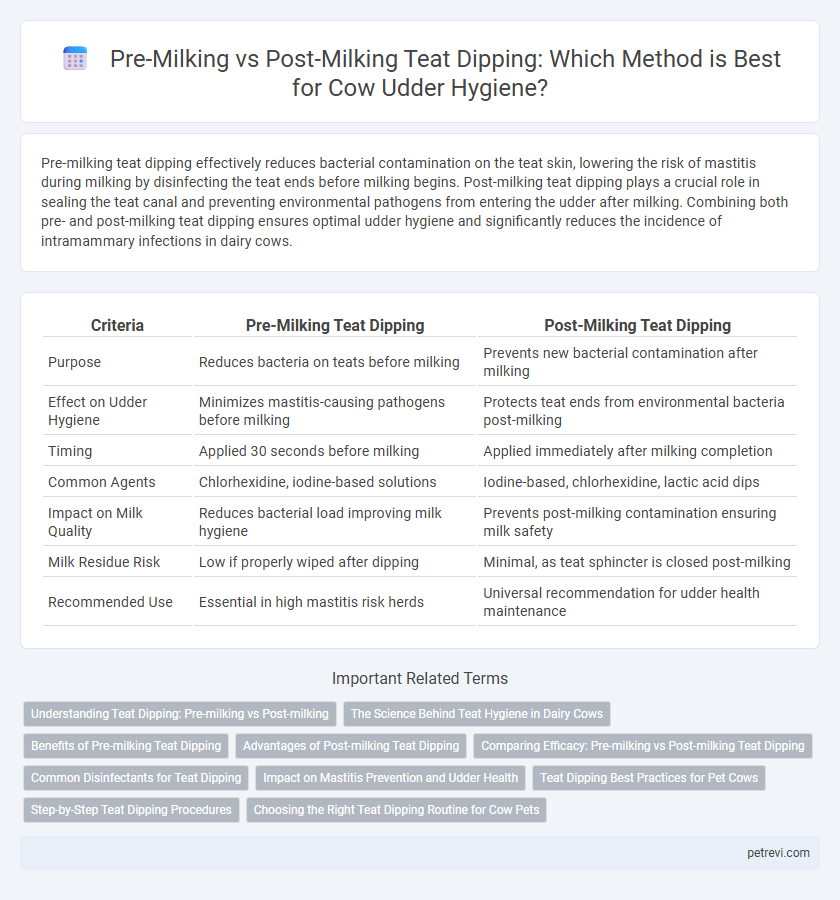Pre-milking teat dipping effectively reduces bacterial contamination on the teat skin, lowering the risk of mastitis during milking by disinfecting the teat ends before milking begins. Post-milking teat dipping plays a crucial role in sealing the teat canal and preventing environmental pathogens from entering the udder after milking. Combining both pre- and post-milking teat dipping ensures optimal udder hygiene and significantly reduces the incidence of intramammary infections in dairy cows.
Table of Comparison
| Criteria | Pre-Milking Teat Dipping | Post-Milking Teat Dipping |
|---|---|---|
| Purpose | Reduces bacteria on teats before milking | Prevents new bacterial contamination after milking |
| Effect on Udder Hygiene | Minimizes mastitis-causing pathogens before milking | Protects teat ends from environmental bacteria post-milking |
| Timing | Applied 30 seconds before milking | Applied immediately after milking completion |
| Common Agents | Chlorhexidine, iodine-based solutions | Iodine-based, chlorhexidine, lactic acid dips |
| Impact on Milk Quality | Reduces bacterial load improving milk hygiene | Prevents post-milking contamination ensuring milk safety |
| Milk Residue Risk | Low if properly wiped after dipping | Minimal, as teat sphincter is closed post-milking |
| Recommended Use | Essential in high mastitis risk herds | Universal recommendation for udder health maintenance |
Understanding Teat Dipping: Pre-milking vs Post-milking
Pre-milking teat dipping reduces bacterial load on the teat skin, preventing pathogens from entering the teat canal during milking, which is crucial for maintaining udder health. Post-milking teat dipping serves as a disinfectant by eliminating bacteria acquired during the milking process and sealing the teat canal to reduce new infections, especially from environmental sources. Both pre-milking and post-milking teat dipping are essential components of effective mastitis control and udder hygiene management in dairy cows.
The Science Behind Teat Hygiene in Dairy Cows
Pre-milking teat dipping reduces the bacterial load on the teat skin, preventing pathogens from entering the teat canal during milking and thereby lowering the incidence of mastitis. Post-milking teat dipping forms a protective barrier that disinfects the teat end and prevents environmental bacteria from colonizing the teat skin after milking. Scientific studies demonstrate that combining both pre- and post-milking teat dipping optimizes udder hygiene by minimizing microbial contamination throughout the milking process.
Benefits of Pre-milking Teat Dipping
Pre-milking teat dipping significantly reduces new intramammary infections by eliminating environmental pathogens before milking, enhancing overall udder health in dairy cows. This practice improves milk quality by lowering bacterial contamination, which leads to reduced somatic cell counts and healthier milk production. Consistent pre-milking teat dipping also protects the teat skin, minimizing irritations and promoting better milk flow during milking sessions.
Advantages of Post-milking Teat Dipping
Post-milking teat dipping significantly reduces the risk of mastitis by eliminating bacteria acquired during milking, promoting udder health and milk quality. It forms a protective barrier that prevents new infections between milkings, enhancing overall herd health management. Research shows that consistent post-milking teat disinfection can decrease somatic cell counts and improve dairy productivity.
Comparing Efficacy: Pre-milking vs Post-milking Teat Dipping
Pre-milking teat dipping effectively reduces the microbial load on the teat surface, lowering the risk of introducing pathogens like Staphylococcus aureus during milking. Post-milking teat dipping provides a protective barrier against environmental bacteria entering the teat canal, which is crucial for preventing new intramammary infections. Research indicates that combining both pre- and post-milking teat dipping yields the highest efficacy in maintaining cow udder hygiene and minimizing mastitis incidence.
Common Disinfectants for Teat Dipping
Common disinfectants for pre-milking teat dipping include iodine-based solutions, chlorhexidine, and quaternary ammonium compounds, which effectively reduce bacterial load and prevent mastitis by disinfecting the teat skin before milking. Post-milking teat dips often incorporate emollients alongside disinfectants like iodine or chlorhexidine to both eliminate residual bacteria after milking and promote teat skin health. Comparing efficacy, iodine-based dips remain the most widely used due to their broad-spectrum antimicrobial properties and residual effect in both pre- and post-milking applications.
Impact on Mastitis Prevention and Udder Health
Pre-milking teat dipping significantly reduces mastitis-causing bacteria on the teat surface, directly minimizing infection risk before milking. Post-milking teat dipping forms a protective barrier that prevents new bacterial invasion during the vulnerable dry period and inter-milking intervals. Combining both pre- and post-milking teat dipping practices optimizes udder health by lowering somatic cell counts and enhancing mastitis prevention efficacy.
Teat Dipping Best Practices for Pet Cows
Pre-milking teat dipping effectively reduces bacterial contamination on the teat surface, minimizing the risk of mastitis in pet cows by cleansing and disinfecting before milking. Post-milking teat dipping forms a protective barrier on the teat skin, preventing new bacterial infections and promoting udder health through moisture retention and skin conditioning. Implementing both pre- and post-milking teat dipping as complementary best practices ensures optimal udder hygiene and reduces mastitis incidence in pet cows.
Step-by-Step Teat Dipping Procedures
Pre-milking teat dipping involves applying an approved disinfectant solution to cow teats before milking to reduce bacterial load and minimize mastitis risk. Post-milking teat dipping requires immediate application of an iodine-based or chlorhexidine disinfectant after milking to create a protective barrier against environmental pathogens. Both procedures demand thorough teat coverage, proper contact time, and use of clean, individual dipping cups or sprays to maximize udder hygiene and milk quality.
Choosing the Right Teat Dipping Routine for Cow Pets
Pre-milking teat dipping effectively reduces bacterial load on cow teats, minimizing the risk of mastitis by eliminating pathogens before milking. Post-milking teat dipping creates a protective barrier that prevents environmental bacteria from entering the teat canal, essential for maintaining udder hygiene. Selecting the appropriate routine for cow pets depends on balancing prevention during milking and protection afterward to ensure optimal udder health.
Pre-milking teat dipping vs Post-milking teat dipping for Cow udder hygiene Infographic

 petrevi.com
petrevi.com